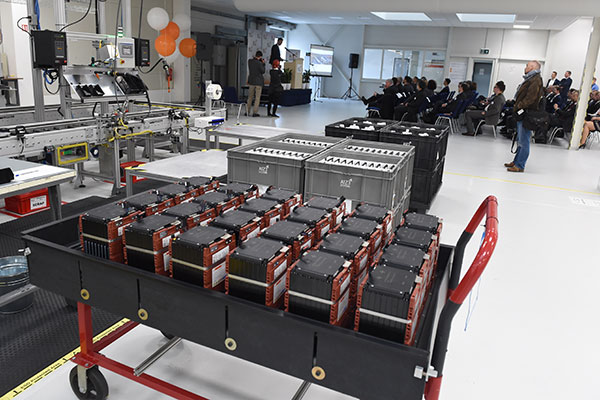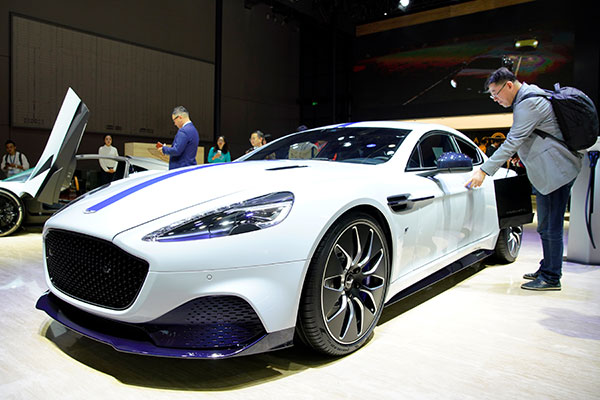
Transport for London, the capital’s transport authority, rolled out in April a new ultra-low emissions zone in the center of the city. Vehicles that do not meet certain emissions standards will have to pay £12.50 per day to enter the zone, in addition to the existing congestion charge.
London has the some of worst air quality in the United Kingdom, according to the King’s College air quality monitoring service, and consistently fails to meet European Union air quality limits. Widespread electric vehicle uptake would contribute to reducing that level.
Vehicles include, but are not limited to, pre-2007 motorbikes that do not meet Euro 3 standards, pre-2006 gasoline cars and light-duty vans under Euro 4 and pre-2015 cars and light-duty diesels under Euro 6. Buses, coaches and trucks must be Euro 6 standards or above or will face a daily charge of £100. Electrified vehicles are exempt.
In 2017, the U.K. government pledged half of all new car sales will be hybrids or EVs by 2030. It backed off of a previously pledged outright ban of internal combustion engines by 2040. There are about 220,000 plug-in EVs registered on the U.K.’s roads and more than 18,685 charge points, according to e-mobility data provider Next Greencar.
The ULEZ will be extended by 2021 to encompass most of the greater London area.
Across the North Sea, authorities in Amsterdam want to ban petrol and diesel cars from the city’s streets by 2030, as part of an environmental plan that aims to fully electrify vehicles, including public transport and boats, and also seeks to implement an inner city clean air zone.
Europe’s highways lack sufficient charging infrastructure for electric and alternatively fueled trucks, says a report released by the European Automobile Manufacturers’ Association. ACEA estimates that at least 6,000 high-voltage charging points would be needed along EU motorways over the next 10 years to meet demand for the growing numbers of e-trucks.
There are an estimated 6 million trucks on Europe’s roads, from of a total fleet of 300 million vehicles, but they are responsible for 25% of European greenhouse gas emissions.
ACEA’s report is in response to proposed EU legislation to reduce carbon dioxide emissions from trucks and buses by 30% by 2030. It wants far lower reduction targets of 7% by 2025 and 16% by 2030.
“The required infrastructure is almost completely absent today, and there is no clear EU action plan for its future roll-out,” an ACEA press statement said.
“The shocking fact is that there is not one single public charging point for long-haul trucks available today,” said ACEA Secretary General Erik Jonnaert in the statement.
Meanwhile, the European Parliament set revised carbon dioxide emission standards for new cars and vans in the EU bloc for the period beginning 2020, setting an interim CO2-reduction goal for cars of 15% for 2025. In 2030, emissions from new cars will have to be 37.5% lower and from new vans 31% lower, compared with 2021.
The EU’s current average caps on CO2 emissions from cars are 130 grams per kilometer set for 2015 and 95 g/km for 2021.
ACEA and its Chinese counterpart, the Chinese Association of Automobile Manufacturers, intend to cooperate on the standardization of new energy vehicles and charging and refueling infrastructure, automated driving and emission standards and testing for both CO2 and pollutants, according to media reports.

China and the EU account for about half of global car sales and production, says ACEA. China is the number two destination for car exports from the EU, and the bloc itself accounts for more than 19% of the global car market, in second place after China.
All IKEA deliveries at Shanghai stores are now being carried out by EVs. The company plans to make all deliveries in New York, Los Angeles, Paris and Amsterdam carbon free by 2020 and across all of China by 2022.
The company partnered with a Shenzhen-based EV truck hire company called DST but intends on purchasing its fleet outright in the future, according to company officials.
The global fleet of electric trucks is estimated to grow by 25% per year from 371,000 in 2017, according to a report by Navigant Research. Delivery companies such as FedEx and UPS are also interested in switching to low emissions vehicles.
Ford invested in Solid Power, a developer of solid-state batteries. The Kentucky-based battery company has raised U.S. $26 million from carmaker Ford, Illinois-based battery tech investment company Volta Energy Technologies, Korea’s Hyundai Center for Robotic-augmented Design in Living Experiences and Samsung Venture Investment Corp., Japan’s Sanoh Industrial Co., Solvay Ventures and Michigan-based cell manufacturer A123 Systems. Solid Power has an existing partnership with BMW.
Solid-state batteries use a solid electrolyte rather than a liquid and have the potential to deliver twice as much range and a longer lifespan in a smaller, lighter unit than the current lithium-ion equivalents. Yet a major challenge to commercial viability is achieving production on a large enough scale.
Compared with lithium-ion batteries, solid-state batteries also run at lower temperatures, requiring less coolant, which could be a blow to lubricant and additive companies looking for other opportunities in the EV realm.
Solid-state batteries are gaining traction among EV investors. Vacuum cleaner and hand drier company Dyson announced plans to build three EVs by 2020, with a long-term aim for them to be powered by solid-state batteries, after an initial run with conventional lithium-ion units.
Ford also invested $500 million in a “skateboard” chassis platform developed by American SUV and pickup EV startup Rivian. Ford intends to use the platform in a new vehicle, which will sit alongside its other battery EV proposals, including a crossover and a zero-emissions pickup.
Rivian has sites in Michigan, California, Illinois and the United Kingdom and has already developed the five-person R1T pickup and seven-person R1S SUV for roll out in the United States in 2020 and the rest of the world in 2021.
All is not well at the joint Tesla-Panasonic Gigafactory, an EV battery plant near Reno, Nevada. The Business Insider, an news website, reported claims by former and current employees of waste on a massive scale caused by operational negligence and sloppy practices, impelled by high production targets.
Some 500,000 cells per day are scrapped amid a “chaotic environment” where “standard operating procedures often go ignored.” Panasonic delivers some 3 million cells to Tesla daily, according to the report, which the carmaker turns into batteries for the Model 3.
Meanwhile, the company lost $702 million in the first quarter of 2019, on the back of weak sales, the repayment of a $920 million bond in March and operational expenses of $640 million.
Global plug-in EV sales grew by than 70% to almost 1.9 million per year in 2018 from 2017 figures, says a market study by Navigant Research. PEV sales in North America doubled over the past year and increased by 39% in Europe and 77% in China in the same period, the study finds.
Bloomberg New Energy Finance predicts less dramatic growth of 40% to 2.6 million units worldwide in 2019. The China Association of Automobile Manufacturers said China will register 1.6 million this year.
Global sales could be buoyed by several new long-range crossover EV launches and Tesla’s Model 3 reaching full production and increasing exports.
German original equipment manufacturers will triple the number of EV models to around 100 in three years, supported by an investment in e-mobility of more than €40 billion, said Bernhard Mattes, president of the German Association of the Automotive Industry, in a speech ahead of the Geneva Motor Show in March.
Elsewhere, two luxury German carmakers, BMW Group and Daimler, will invest €1 billion to merge their car-sharing, ride-hailing, parking, charging and multimodal transport services, creating an all-electric, on-demand autonomous mobility company. Its new charging initiative, called ChargeNow, is already operational and makes public charge points easy to locate, use and pay for.
Allison Transmission, an American manufacturer of medium- and heavy-duty fully automatic transmissions, acquired Vantage Power, a U.K. start-up in electrification, battery system and vehicle telematics, and AxleTech’s EV systems division. The acquisitions are part of Allison’s ongoing move into the commercial e-mobility market, having already introduced a new e-axle system for commercial vehicles. Its new AXE series e-axle is a fully integrated electric powertrain system that fits inside a standard frame along the axles of commercial trucks and comprises electric motors, a two-speed gearbox, oil coolers, pumps and power electronics, Allison said.
Japanese car giant Toyota Motor Corp. will produce EVs based on its RAV4 SUV crossover and Corolla station wagon for Suzuki Motor Corp. for sale in Europe. Suzuki will reciprocate by sourcing hybrid systems for cars it sells worldwide and producing conventional engine compact models for Toyota in India, Europe and Africa.
Meanwhile, compatriot carmaker Honda says it wants two-thirds of its unit sales to be electrified by 2030, a move that is in line with a growing number of European and Asian OEMs within a similar timeframe.
Rumors have it that James Bond will race around the set of his newest movie in a Rapide E, an electrified version of the high-end carmaker Aston Martin’s gasoline engine Rapide S.
The Rapide E has a range of 200 miles on one charge, not quite enough to get Bond from London to Berlin in one night, but plenty to zip around the streets in a car chase when he eventually arrives.

But rather than boosting sales of the U.K. marque’s latest EV model, the production run is limited to just 155 units. Aston has decided to leave EV production to its ultra-luxury brand Lagonda, which has a sedan and sports utility EV in the pipeline. Aston claims Lagonda will be the world’s first zero-emissions luxury car brand.
City Hall in Los Angeles introduced measures to ensure a zero-carbon power grid, transportation and buildings, and zero waste and wasted water by 2050. The measures aim to increase EVs in the city to 25% by 2025 and 100% by 2050, as well as convert all city vehicles to zero emissions by 2028 and increase charging infrastructure.
Owners of EVs, hybrids and electric motorbikes in North Dakota will now face annual fees of up to $120 for the upkeep of the state’s roads and bridges, money usually collected from gasoline tax. It joins 20 other states imposing fees on EVs, including California, Colorado, Georgia, Indiana, Michigan, Minnesota, Mississippi, Missouri, Nebraska, North Carolina, Ohio, Oklahoma, Oregon, South Carolina, Tennessee, Utah, Virginia, West Virginia, Washington and Wyoming. North Dakota has fewer than 150 EVs and 4,000 hybrids and a handful of plug-in hybrids, so the revenue generated will be relatively minimal compared with fossil-fueled vehicles.
Further west on the Pacific coast, state legislators in Olympia, Washington passed a bill that adds $75 on top of annual fees EV owners stump up to fund development of EV infrastructure. They are already charged $150 to offset lost revenue from gasoline sales.
The bill also establishes tax credits and incentives to encourage uptake of EV commercial vehicles and buses and for electric vehicle charging infrastructure.
The city of Seattle now mandates parking facilities must have charging infrastructure. In 2016, the city started “Drive Clean Seattle,” an effort to electrify the city’s own fleet. It also provides incentives for private parties to move away from fossil fuels. At the time, the goal was to have 15,000 electric vehicles on Seattle-area roads by 2025.
A bill to hike annual EV fees in North Carolina has stalled in its progress through the legislature while a proposal to fine drivers of gasoline-powered cars for blocking charging plugs for EVs looks set to pass. The move echoes similar calls for fines for charging point blocking in Denver, where offenders are nicknamed “ICEholes.”